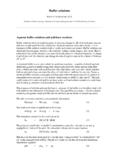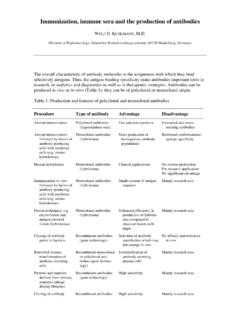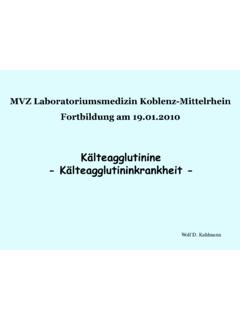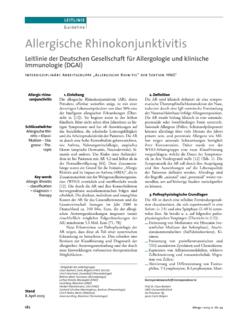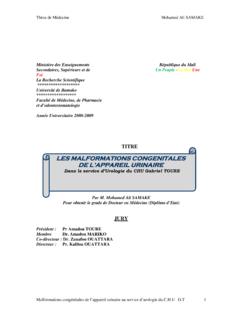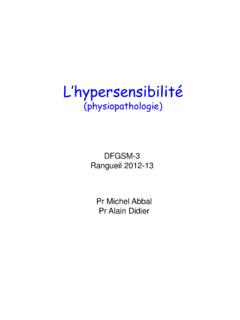Transcription of Haematoxylin staining methods - immunologie …
1 Haematoxylin staining methods WOLF D. KUHLMANN, Division of Radiooncology, Deutsches Krebsforschungszentrum, 69120 Heidelberg, Germany Subsequent to immunohistological procedures, counterstaining of tissue sections is helpful for the study of histological and histopathological details. Generally, counterstains are used to obtain supplementary information to that of the primary stain. An effective counterstain should not intrude the major stain, the immunostained antigen in the tissue section. The right selection of a counterstain will result in important additional information. In most cases, the overall morphology of the tissue section or the staining of nuclear morphology is desired. For the latter, a variety of Haematoxylin formulations exist. With our DAB reactions we obtain nice conterstains by using GILL S or MAYER S haematoxylins. Haematoxylin is obtained from the logwood Haematoxylon campechianum, a tree indigenous to Central America by several extraction and precipitation methods .
2 Haematoxylin can be also produced synthetically, but the natural product is still the agent in common use. The dye was originally used for industrial purpose. In the first attempts to use Haematoxylin as a direct dye for histological specimens only poor results were obtained. The potential for Haematoxylin in microscopy has been first realized by F B HMER (1865) who combined a metallic mordant with Haematoxylin to stain tissue sections adequately. Since then, Haematoxylin dye solutions contain Haematoxylin and an alum (hemalum, alum Haematoxylin ). Coupling of Haematoxylin with a mordant is still the major form in which this dye is used. Many formulations have been devised in the meantime. They vary in the amount of Haematoxylin , the type and quantity of aluminium salts, solvents, oxidizing agents and stabilizers. Also, other ingredients may be added. They are not essential but can modify the behaviour of the Haematoxylin dyes.
3 Formulations of Haematoxylin stains Since the introduction of Haematoxylin as histological dye, many staining formulations have been suggested. Here, examples of the enduring Haematoxylin staining methods are given. Haematoxylin (Delafield) Chemicals Chemical solution Haematoxylin ( 75290) Ammonium aluminium sulfate (ammonium Ammonium alum stock solution: saturated ammonium alum in distilled water (about 10%) Dyes and other chemicals in histological staining can be toxic. They must be handled with care alum) Sodium iodate Glycerol Sodium hydrogen carbonate Ethanol Distilled water Haematoxylin stock solution: g Haematoxylin dissolved in mL 96% ethanol Sodium iodate stock: g sodium iodate dissolved in mL distilled water DELAFIELD stock solution: mL Haematoxylin stock plus mL sodium iodate stock mix and wait for 10 min, add 160 mL ammonium alum stock mix vigorously for 1 min, add mL glycerol the final mixture is filtered DELAFIELD dye solution: Delafield haemalum stock solution 1:40 diluted with distilled water sodium hydrogen carbonate in distilled water staining procedure Immuno-stained sections are passed through distilled water and stained.
4 DELAFIELD dye solution 1-6 hours running tap water 30 min sodium hydrogen carbonate under microscopic control (to blue ) distilled water 2 x 1 min Slides are dehydrated in ascending series of ethanol and mounted under coverglass Haematoxylin (Ehrlich) Chemicals Chemical solution Haematoxylin ( 75290) Potassium aluminium sulfate (potassium alum) Potassium iodate Isopropanol Glycerol Glacial acetic acid HCl (25%) Sodium hydrogen carbonate EHRLICH haemalum dye solution: g Haematoxylin dissolved in mL 96% isopropanol the following substances are added in the order given: (a) mL distilled water (b) mL glycerol (c) g potassium alum (d) mL glacial acetic acid mix, add g potassium iodate Ammonia aqueous Distilled water and mix again the dye solution is ready for use HCl solution in distilled water sodium hydrogen carbonate in distilled water Ammonia water: 50 L ammonia aqueous in 100 mL distilled water staining procedure Immuno-stained sections are passed through distilled water and stained.
5 EHRLICH haemalum dye solution 2-15 min running tap water 30 min sodium hydrogen carbonate under microscopic control (to blue ) differentiate in HCl solution under microscopic control (when color is too strong) rinse in tap water 1 min ammonia water under microscopic control (to blue ) running tap water 30 min distilled water 2 x 1 min Slides are dehydrated in ascending series of ethanol and mounted under coverglass Haematoxylin (Gill) Chemicals Chemical solution Haematoxylin ( 75290) Aluminium sulfate Ethylene glycol Sodium iodate Glacial acetic acid HCl (25%) Sodium hydrogen carbonate Ammonia aqueous Distilled water GILL Haematoxylin dye solution (triple): g Haematoxylin dissolved in mL distilled water plus mL ethylene glycol plus g sodium iodate plus g aluminium sulfate plus 20 mL glacial acetic acid Reagents are combined in the order given, mix for 1 hour at room temperature.
6 The dye solution is ready for use HCl solution in distilled water sodium hydrogen carbonate in distilled water Ammonia water: 50 L ammonia aqueous in 100 mL distilled water staining procedure Immuno-stained sections are passed through distilled water and stained: GILL Haematoxylin dye solution (triple) 2-15 min running tap water 30min sodium hydrogen carbonate under microscopic control (to blue ) differentiate in HCl solution under microscopic control (when color is too strong) rinse in tap water 1 min ammonia water under microscopic control (to blue ) running tap water 30 min distilled water 2 x 1 min Slides are dehydrated in ascending series of ethanol and mounted under coverglass Haematoxylin (Hansen) Chemicals Chemical solution Haematoxylin ( 75290) Ammonium ferric sulfate (iron alum) Ethanol HCl (25%) Sodium hydrogen carbonate Distilled water Iron alum stock solution: g iron alum dissolved in mL distilled water Haematoxylin stock solution: g Haematoxylin dissolved in mL distilled water HANSEN Haematoxylin dye solution.
7 Iron alum stock and Haematoxylin stock solutions are mixed and heated until the boiling point is reached let the final mixture cool down and filter HCl-ethanol solution: mL absolute ethanol plus mL distilled water plus mL HCl (25%) sodium hydrogen carbonate in distilled water staining procedure Immuno-stained sections are passed through distilled water and stained: HANSEN Haematoxylin dye solution 30 min running tap water 1-5 min differentiate in HCl-ethanol solution under microscopic control (when color is too strong) rinse in tap water 1 min sodium hydrogen carbonate under microscopic control (to blue ) running tap water 30 min distilled water 2 x 1 min Slides are dehydrated in ascending series of ethanol and mounted under coverglass Haematoxylin (Harris) Chemicals Chemical solution Haematoxylin ( 75290) Potassium aluminium sulfate (potassium alum) Ethanol Mercury (II) oxide (mercuric oxide) Glacial acetic acid HCl (25%) Sodium hydrogen carbonate Ammonia aqueous Distilled water Potassium alum stock solution: g potassium alum dissolved in mL distilled water (using heat if necessary) Haematoxylin stock solution.
8 G Haematoxylin dissolved in mL absolute ethanol HARRIS Haematoxylin dye solution: Haematoxylin stock and potassium alum stock solutions are mixed bring rapidly to the boil and carefully add g mercuric oxide (little at a time because of foaming!); cool the mixture rapidly by immersing the flask into iced water the dye solution is ready to use as soon as it is cool the stain is filtered prior to use optinonally: addition of mL glacial acetic acid (for sharper nuclear staining ) HCl solution in distilled water sodium hydrogen carbonate in distilled water Ammonia water: 50 L ammonia solution in 100 mL distilled water staining procedure Immuno-stained sections are passed through distilled water and stained: HARRIS Haematoxylin dye solution 1-5min running tap water 10 min sodium hydrogen carbonate under microscopic control (to blue ) differentiate in HCl solution under microscopic control (when color is too strong) rinse in tap water 1 min ammonia water under microscopic control (to blue ) running tap water 30 min distilled water 2 x 1 min Slides are dehydrated in ascending series of ethanol and mounted under coverglass Haematoxylin (Heidenhain) Chemicals Chemical solution Haematoxylin ( 75290) Ammonium ferric sulfate (iron alum) Ethanol Sodium iodate Glacial acetic acid Sulfuric acid Sodium hydrogen carbonate Distilled water Haematoxylin stock solution: g Haematoxylin dissolved in mL 96% ethanol plus mL distilled water plus g sodium iodate (solution is ready to use) HEIDENHAIN Haematoxylin dye solution.
9 ML Haematoxylin stock dissolved in mL distilled water Iron alum solution (I): g iron alum dissolved in mL distilled water and the following substances are added: (a) mL glacial acetic acid (b) mL sulfuric acid Iron alum solution (II): g iron alum dissolved in mL distilled water sodium hydrogen carbonate in distilled water staining procedure Immuno-stained sections are passed through distilled water and stained: Iron alum solution (I) 1-6 hours HEIDENHAIN Haematoxylin dye solution 1-3 hours distilled water rinse differentiate in iron alum solution (II) under microscopic control running tap water 10 min sodium hydrogen carbonate under microscopic control (to blue ) running tap water 30 min distilled water 2 x 1 min Slides are dehydrated in ascending series of ethanol and mounted under coverglass Haematoxylin (Mayer) Chemicals Chemical solution Haematoxylin ( 75290) Potassium aluminium sulfate (potassium alum) Sodium iodate Chloralhydrate Citric acid HCl (25%) Sodium hydrogen carbonate Ammonia aqueous Distilled water Haematoxylin stock solution: g Haematoxylin dissolved in 1000 mL distilled water plus g sodium iodate plus g potassium alum MAYER Haematoxylin dye solution.
10 ML Haematoxylin stock plus g chloralhydrate plus g citric acid solution is mixed and filtered prior to use HCl solution in distilled water sodium hydrogen carbonate in distilled water Ammonia water: 50 L ammonia solution in 100 mL distilled water staining procedure Immuno-stained sections are passed through distilled water and stained: MAYER Haematoxylin dye solution 5-10 min (microscopic control) running tap water 30 min sodium hydrogen carbonate under microscopic control (to blue ) differentiate in HCl solution under microscopic control (when color is too strong) rinse in tap water 1 min ammonia water under microscopic control (to blue ) running tap water 30 min distilled water 2 x 1 min Slides are dehydrated in ascending series of ethanol and mounted under coverglass Haematoxylin (Weigert) Chemicals Chemical solution Haematoxylin ( 75290) Iron (III) chloride (ferric chloride) Ethanol HCl (25%) Sodium hydrogen carbonate Distilled water Haematoxylin stock solution: g Haematoxylin dissolved in mL 96% ethanol mixture should mature for 1 week Iron (III) chloride stock solution.
